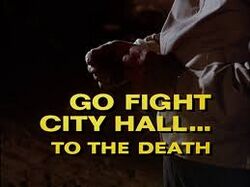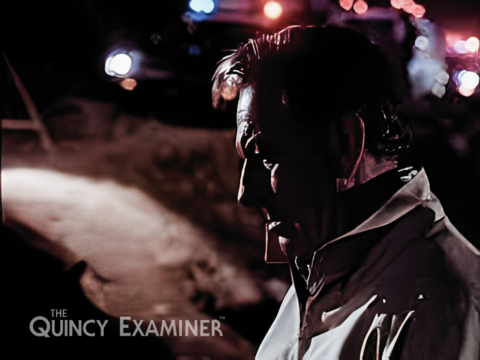Go Fight City Hall... to the Death (Quincy, M.E.)
| Go Fight City Hall… to the Death | ||||||||||||||||||||||||||||||||||||||
|---|---|---|---|---|---|---|---|---|---|---|---|---|---|---|---|---|---|---|---|---|---|---|---|---|---|---|---|---|---|---|---|---|---|---|---|---|---|---|

| ||||||||||||||||||||||||||||||||||||||
|
Episode Quote
"Something in me goes tilt, when I see a life end before its time and I wanna do something about it. I want to find out who made that terrible thing happen…"
~ Dr. Quincy, in Go Fight City Hall… to the Death!
Episode Overview
Go Fight City Hall… to the Death is the pilot episode of the Quincy, M.E. television series. It originally aired on NBC on October 3, 1976, as part of the NBC Mystery Movie anthology. The episode introduces Dr. R. Quincy, a forensic pathologist who challenges institutional authority in his pursuit of justice.
Table of Contents
Application of The QME Episode Laws
Go Fight City Hall… to the Death! serves as a foundational exemplar of **The QME Episode Laws**, a set of guiding principles that shaped the narrative framework of the entire series.
✅ Law 1: A Quincy, M.E. story must always seek to uncover the truth and bring justice to the victim.** From its opening scenes, the pilot challenges the initial suicide ruling and follows Quincy’s relentless investigation to reveal a murder and larger conspiracy. The episode’s central victim, Karen Latham, is posthumously vindicated through Quincy’s determination to expose the truth.
✅ Law 2: A Quincy, M.E. story must explore the social and ethical issues surrounding the case, and particularly the struggle for justice against powerful systems.** The episode directly confronts political corruption and institutional indifference. Quincy battles City Hall, the police department, and even his own coroner’s office hierarchy in a broader ethical crusade for accountability, making it a textbook case of the show's moral imperative.
✅ Law 3: A Quincy, M.E. story must never shy away from complex or controversial topics, but always approach them with sensitivity and respect.** The narrative addresses whistleblowing, government malfeasance, and public trust—topics rarely explored in depth on 1970s network television. The writing balances suspense with real-world gravity, exemplifying this law’s intent.
✅ Law 4: A Quincy, M.E. story must strive for scientific accuracy in its medical and forensic investigations.** The pilot’s emphasis on autopsy findings, forensic fingerprint comparisons, and x-ray analysis establishes the show’s enduring commitment to medical credibility. Even minute inconsistencies, such as the victim’s non-smoking status conflicting with planted evidence, reflect this dedication.
Together, these narrative choices affirm that the pilot did more than introduce characters—it set a durable blueprint for what *Quincy, M.E.* would represent: **truth, integrity, and socially conscious storytelling grounded in science**.
Episode Synopsis
After discovering evidence tampering caused by poor detective work, Quincy and Monahan exchange viewpoints on proper investigation procedures. Just then, Brill reports another crime with a victim/suspect still alive, suggesting a connection. Quincy and Monahan race to the scene to find leads related to the Jane Doe discovered on the beach. Upon arrival, Quincy investigates the perpetrator, Peter Gordon, suffering two bullet wounds from police fire and losing blood rapidly. Paramedics transport Gordon for treatment, while Quincy and Monahan discuss possible links between the two crimes. Monahan informs Quincy about a wallet containing a picture of the victim found in a purse in the perpetrator’s possession.
Back at the LACC, Sam and Quincy attempt to lift fingerprints from Jane Doe’s neck but fail due to the time elapsed since death affecting lab results. However, Sam notes they have an outline of the killer’s hands. Quincy presents his findings to Monahan at police headquarters, proposing the purse snatcher could be the homicide suspect. Quincy maintains room for interpretation, while Monahan sees it as an open-and-shut case. Quincy compares photo imprints of the killer’s hands on the victim’s neck with the purse snatcher’s hand size, arguing he is not the killer.
The medical examiner's report indicates the victim did not smoke, yet a cigarette pack was found at the crime scene. Quincy questions this discrepancy as Monahan continues to believe it’s a crime of passion. Quincy visits City Hall to investigate the victim Diane Johnson’s former workplace.
Speaking with receptionist Ms. Peggy Tobin, Quincy learns Johnson worked there for three months after transferring from the controller’s office. Quincy meets Comptroller Harold P. Marcus, who stonewalls inquiries. Quincy secretly listens to Marcus, who expresses fear after Quincy’s visit. Quincy visits Lee Porter, his girlfriend, for dinner. Quincy reminds Lee of their “no strings attached” relationship. Sam calls with news that Marcus has been found dead.
Initial crime scene findings suggest Marcus hung himself. However, Monahan and Quincy suspect homicide after noting snapped vertebrae, inconsistent with hanging’s elongated vertebrae. A suicide note was found in Marcus’s locked office. Peggy reveals that Diane Johnson and another City Hall worker were killed after a trip to Mexico with a fiancé, who never returned to collect belongings.
Quincy investigates further, learning the fiancé survived a car that went over a cliff but the other passenger died of a broken neck.
At LACC, Quincy meets Dr. Asten, who arranges a meeting with Deputy Mayor Collins. Quincy suspects City Hall cover-up but is warned off by police. Quincy and Lee attend a Dodgers game where Quincy confronts Collins, who lies about attending on short notice. Quincy declares his distrust.
Suspecting conspiracy, Quincy and Lee travel to Mexico. Quincy has a victim’s body exhumed, finding the victim died before the accident. The supposed fiancé’s name and address are fake. During the investigation, their rental car is forced off a cliff by a hired truck driver. Quincy and Lee survive and Lee is hospitalized.
Quincy learns some City Hall officials’ belongings were among the deceased in Mexico. Back in LA, Quincy investigates Harbor Commissioner Arnold Bower’s office. Bower is killed by the same killer on his ship. Quincy and Monahan argue over findings; Quincy links the murder to City Hall corruption.
Off duty, Quincy learns City Hall is involved in a $3 million bad checks scandal. Quincy reviews Mexican hospital x-rays and discusses concerns with Lee while driving back to LA. Quincy notices a suspicious vehicle following them. The killer attacks; Quincy uses a nerve pinch to escape. Mexican police arrest the assailant, who is later turned over to international authorities.
Plot Summary
The pilot follows Dr. Quincy as he investigates a suspicious death originally ruled a suicide but revealed as murder linked to political corruption. Quincy’s forensic work uncovers a cover-up involving City Hall officials, setting the tone for the series’ emphasis on truth and social justice.
← N/A (Pilot) • Go Fight City Hall… to the Death! • A Star Is Dead Season 1 Overview: Full Episode List
Main Cast
- Jack Klugman as Dr. R. Quincy
- Robert Ito as Sam Fujiyama (absent from pilot)
Guest Cast
- Martha Smith as Dianne Johnson (Jane Doe)
- Lynette Mettey as Lee Porter
- Henry Darrow as Dr. Rivera
- Hari Rhodes as Deputy Mayor Collins (credited as Harry Rhodes)
- Denny Miller as Benjamin Chase
- John S. Ragin as Dr. Asten
- Garry Walberg as Lt. Monahan
Case File Summary
Victim: Jane Doe (later identified as Karen Latham) Case #: LACC 76.10.835
Dr. Quincy challenges the initial suicide ruling, using forensic techniques to uncover murder and political conspiracy. Karen Latham was silenced after discovering budget irregularities.
Additional Victims
- Peter Gordon – whistleblower
- Harold P. Marcus – records clerk
- Arnold Bower – city accountant
- Unnamed contract killer – suspected enforcer linked to Benjamin Chase
Alleged Perpetrator
- Benjamin Chase (portrayed by Denny Miller) – charged with killing the victim on the beach
- Arnold Bower - corrupt businessman orchestrating the cover-up.
Filming Locations and Exterior Footage
Local filming locations in and around Los Angeles included the Los Angeles City Hall, Los Angeles Police Department, and Los Angeles County Coroner's Office, providing authentic exterior footage to enhance realism for the series.
Los Angeles City Courthouse exterior filming location for Quincy, M.E. Los Angeles Police Department exterior used in Quincy, M.E. Entrance to Los Angeles County Coroner's Office filming location
Forensic Science Insight
- The episode realistically portrays challenges in fingerprint lifting due to postmortem decomposition, a common forensic obstacle.
- Quincy’s comparison of handprint sizes illustrates forensic anthropometry in suspect exclusion.
- Autopsy findings of snapped vertebrae contradict typical hanging injuries, suggesting foul play.
- Discrepancy between victim’s non-smoking status and presence of cigarettes at the scene highlights staged crime scene techniques.
- Use of radiology (x-rays) for victim identity and injury analysis underscores forensic pathology methods.
Themes & Tropes
- Bureaucratic Resistance – Quincy’s clash with police and City Hall showcases institutional obstacles.
- Cover-Up and Conspiracy – political corruption forms a dark narrative backdrop.
- The Reluctant Hero – Quincy’s persistence despite opposition frames his moral journey.
- Forensic Science as Justice – scientific rigor triumphs over assumption.
- Moral Ambiguity – conflicting evidence interpretations challenge law and order.
Reception & Ratings
The pilot episode received positive acclaim, noted for combining forensic accuracy with compelling social issues.
- IMDb rates the episode 7.5/10 from over 250 user reviews ([IMDb Pilot Episode](https://www.imdb.com/title/tt0074042/episodes/?utm_source=quincyexaminer.com)).
- Quincy fan forums praise Jack Klugman’s portrayal and pioneering forensic drama elements ([Quincy Forums](https://www.quincyexaminer.com/forum)).
- Critics commend its realism and socially conscious storytelling for 1970s television.
Trivia
- Martha Smith reprised similar roles in other contemporary crime series.
- Exterior shots filmed at authentic LA government buildings enhance atmosphere.
- Jack Klugman studied real forensic pathologists to prepare for the role.
- Forensic montage sequences became a recurring stylistic hallmark of the series.
- Quincy and Monahan’s tense dynamic established an ongoing dramatic motif.
Cultural Impact
Go Fight City Hall… to the Death! set the template for forensic crime dramas, influencing later series such as CSI and Bones. Quincy’s role popularized forensic science on television and raised awareness of institutional corruption during the 1970s.
See Also
External Links
- [Original Quincy, M.E. site](https://www.quincyexaminer.com "Visit The Quincy Examiner Official Website anytime")
- [IMDb page for Go Fight City Hall… to the Death!](https://www.imdb.com/title/tt0074042/episodes/?utm_source=quincyexaminer.com "IMDb Quincy Pilot Episode")
- [Quincy, M.E. episode guide on TV.com](https://www.tv.com/shows/quincy-me/ "TV.com Quincy Guide")
- [Reddit Quincy Fan Community](https://www.reddit.com/r/QuincyME/ "Reddit Quincy, M.E. Discussion")

